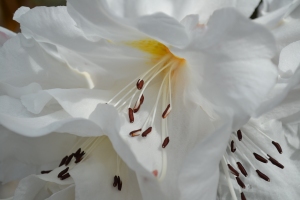Fiction writers have more in common with writers of non-fiction than they might believe. Here’s an example of non-fiction from the world of Fibonacci numbers and mathematics.

Rhododendrons
My wife and partner, Carolynn and I visited the Rhododendron gardens in Federal Way, Washington over the past weekend. Many of the plants were in bloom and we’ll be returning in a week or so to see many others which hadn’t bloomed yet. As we gazed at the intense colors of the blooms and the compact buds that were just opening, I was reminded of the Fibonacci series.
The numbers consist of the unending series:
0, 1, 1, 2, 3, 5, 8, 13, 21, 34, 55, 89…
Fibonacci, Leonardo Pisano, lived in Pisa, Italy around 1200AD and gave his name to the Fibonacci numbers.

Carolynn at Weyerhauser Rhododendron Garden
Fibonacci numbers can also be seen in the arrangement of seeds on flower heads such as the Coneflower or sunflower. Look at the way the petals of a flower are arranged. You will find them in 2s, 3s, 5s and more, but no fours. If you think you have found a flower with four petals look closer and you will notice that two of the “petals” are actually part of the reproductive parts of the plant! For some reason, nature doesn’t like the number four.


Most daisies, for example, have 34, 55, or 89 petals which are the 9th,10th, and 11th Fibonacci numbers.

I have enjoyed numbers most of my life. One of the best definitions of mathematics is that it makes the invisible visible. Every time we take a ride on a jet there was a team of engineers who used mathematics to design and build that plane so it will go safely through the air at 400 miles per hour. We can’t see what they’ve done just looking at the airplane and most of us wouldn’t even recognize the Navier-Stokes differential equation that was used to design the wings; but without that equation and its proper use the plane would have never left the ground.
Did you know that it’s a good thing bees can’t read? If they could, they might find out that, from an aeronautical perspective which considers their wing area and body size, the bee shouldn’t be able to fly. Being illiterate the bee just flaps the heck out of its wings and flies on his merry way.
I could have shortened this drastically by simply writing the series. Wouldn’t that have been boring? I add to the facts by using imagery of flowers and leaves. I then provide a definition of mathematics the reader most likely hasn’t thought of and then a humorous story about the bee. These are obviously the same techniques I use when I write fiction. Surely this makes the rather dry subject of Fibonacci numbers and mathematics in general come to life. Would you agree?
All photos were taken by Richard Alan.
